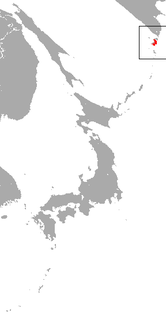
The Somali hedgehog is a species of mammal in the family Erinaceidae. It is endemic to Somalia and Somaliland. The Somali hedgehog is nocturnal.

The Ugandan lowland shrew is a species of mammal in the family Soricidae. It is found in Kenya and Uganda. Its natural habitats are subtropical or tropical swamps and subtropical or tropical moist montane forest. It is threatened by habitat loss.

The Paramushir shrew is a species of mammal in the family Soricidae. It is endemic to Russia. Its natural habitat is temperate forests. It is threatened by habitat loss.

Day's shrew is a species of mammal in the family Soricidae. It is endemic to India. Its natural habitat is subtropical or tropical dry forests. It is threatened by habitat loss.
Epigomphus camelus is a species of dragonfly in the family Gomphidae. It is endemic to Costa Rica. Its natural habitats are subtropical or tropical moist lowland forests and rivers. It is threatened by habitat loss.
Epigomphus is a genus of dragonflies in the family Gomphidae. They are commonly known as Knobtails.
Epigomphus clavatus is a species of dragonfly in the family Gomphidae. It is endemic to Guatemala. Its natural habitats are subtropical or tropical moist montane forests and rivers. It is threatened by habitat loss.
Epigomphus crepidus is a species of dragonfly in the family Gomphidae. It is endemic to Mexico. Its natural habitats are subtropical or tropical moist lowland forests and rivers. It is threatened by habitat loss.
Epigomphus donnellyi is a species of dragonfly in the family Gomphidae. It is endemic to Mexico. Its natural habitats are subtropical or tropical moist lowland forests and rivers. It is threatened by habitat loss.
Epigomphus echeverrii is a species of dragonfly in the family Gomphidae. It is endemic to Costa Rica. Its natural habitats are subtropical or tropical moist lowland forests and rivers. It is threatened by habitat loss.
Epigomphus flinti is a species of dragonfly in the family Gomphidae. It is endemic to Mexico. Its natural habitats are subtropical or tropical moist lowland forests and rivers. It is threatened by habitat loss.
Epigomphus houghtoni is a species of dragonfly in the family Gomphidae. It is endemic to Costa Rica. Its natural habitats are subtropical or tropical moist lowland forests and rivers. It is threatened by habitat loss.
Epigomphus maya is a species of dragonfly in the family Gomphidae. It is endemic to Belize. Its natural habitats are subtropical or tropical moist lowland forests and rivers. It is threatened by habitat loss.
Epigomphus paulsoni is a species of dragonfly in the family Gomphidae. It is endemic to Mexico. Its natural habitats are subtropical or tropical moist lowland forests and rivers. It is threatened by habitat loss.
Epigomphus subsimilis is a species of dragonfly in the family Gomphidae. It is endemic to Costa Rica. Its natural habitats are subtropical or tropical moist lowland forests and rivers. It is threatened by habitat loss.
Epigomphus sulcatistyla is a species of dragonfly in the family Gomphidae. It is endemic to Mexico. Its natural habitats are subtropical or tropical moist lowland forests and rivers. It is threatened by habitat loss.
Epigomphus verticicornis is a species of dragonfly in the family Gomphidae. It is endemic to Costa Rica. Its natural habitats are subtropical or tropical moist lowland forests and rivers. It is threatened by habitat loss.
Epigomphus westfalli is a species of dragonfly in the family Gomphidae. It is endemic to Nicaragua. Its natural habitats are subtropical or tropical moist lowland forests and rivers. It is threatened by habitat loss.




